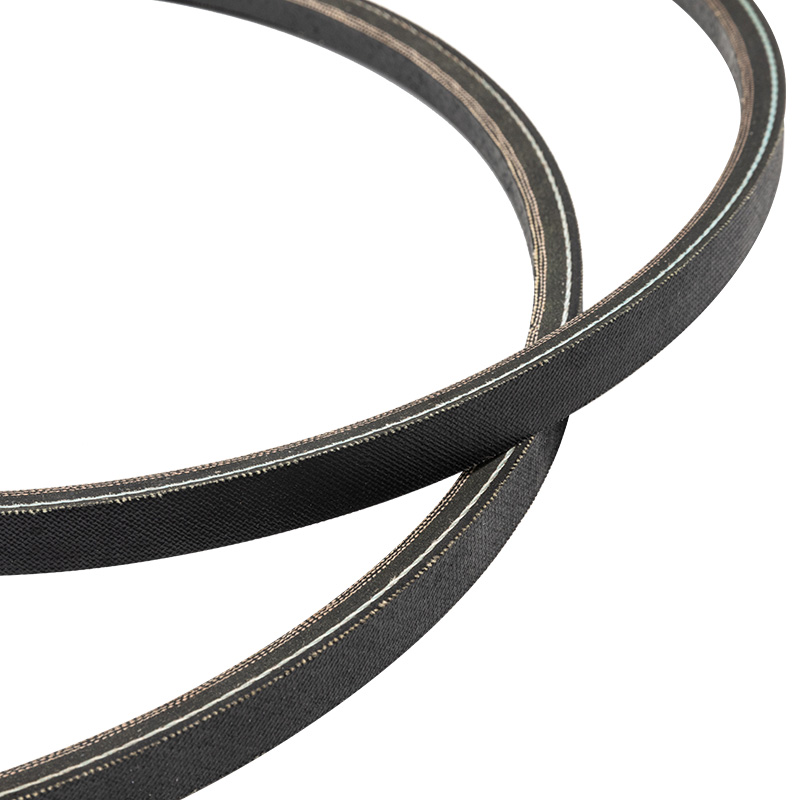The construction of Raw Edge V-Belts is designed to enhance performance and durability in automotive systems through several key features:
Material Selection: Raw Edge V-Belts are meticulously crafted from a blend of synthetic rubber compounds, chosen for their specific chemical properties. These compounds often include a combination of butadiene, styrene, and other polymers, each selected to contribute distinct characteristics. Additives, such as carbon black for reinforcement and various stabilizers, are carefully blended to create a compound with optimal wear resistance, heat dissipation, and resistance to environmental factors.
Fabric Reinforcement: The fabric or fiber reinforcement layers play a critical role in fortifying the structural integrity of Raw Edge V-Belts. Advanced materials like aramid, known for their exceptional tensile strength and resistance to stretching, are intricately woven into a grid-like pattern. The weaving pattern, thread density, and alignment are fine-tuned through computer-aided design (CAD) simulations and material testing to achieve an optimal balance between flexibility and strength.
Cord Placement: Cord placement within Raw Edge V-Belts is an art and science combined. Engineers employ advanced modeling techniques to simulate stress distribution across various cord layouts. The goal is to evenly distribute forces, minimizing localized stress points that could lead to premature wear. Finite element analysis (FEA) is often employed to iteratively refine the cord placement for optimal load-sharing capabilities.
Cord Type: The choice of cord type involves a deep dive into material science. Whether it's aramid or polyester, the cords are subjected to rigorous quality control measures. Molecular alignment and tensile strength are scrutinized to ensure consistent performance. The manufacturing process involves precision twisting and embedding into the belt matrix, creating a composite structure that resists not only tension but also fatigue and environmental influences.
Cut Edge Design: The cut edge design is a result of extensive aerodynamic and tribological studies. It's not just about appearance; it's a deliberate engineering decision to minimize friction and heat generation at the edge of the belt. Computational fluid dynamics (CFD) simulations are used to analyze airflow around the belt, optimizing the cut edge shape for reduced turbulence and improved cooling during operation.
Precision Manufacturing: Precision manufacturing of Raw Edge V-Belts involves multi-step processes that demand tight control. Molding techniques utilize custom-designed molds with precisely engineered profiles. Quality control measures include laser-guided inspections and automated testing to ensure each belt meets stringent dimensional tolerances. Vulcanization parameters, such as temperature and curing time, are meticulously controlled to maintain uniform material properties.
Heat Resistance: Heat resistance is achieved through a combination of material formulation and structural design. The rubber compounds are engineered with heat-resistant polymers and cross-linking agents. Molecular chains are designed to withstand thermal stress without sacrificing flexibility. Thermal imaging and thermographic analysis are employed to assess heat dissipation during operation, ensuring the belt remains within optimal temperature ranges.
Oil and Chemical Resistance: Achieving oil and chemical resistance involves a deep understanding of polymer chemistry. Raw Edge V-Belts incorporate specialized polymer blends with resistance to oil, fuels, and various chemicals. These polymers are carefully selected and tested against a range of substances to ensure long-term durability. Swell tests and immersion studies are conducted to assess the belt's resilience in the presence of different automotive fluids.
Flexibility and Adaptability: The flexibility of Raw Edge V-Belts is a result of a comprehensive approach to elastomer formulation. Engineers optimize the polymer matrix to provide the necessary elasticity for bending around pulleys without sacrificing strength. Dynamic modulus testing and real-world simulations are conducted to evaluate how well the belt adapts to varying pulley geometries and operational conditions, ensuring reliable performance in diverse automotive applications.
Automotive Raw Edge V-Belts


 View More >>
View More >>
 View More >>
View More >>
 View More >>
View More >>
 View More >>
View More >>
 View More >>
View More >>
 View More >>
View More >>
 View More >>
View More >>
 View More >>
View More >>
 View More >>
View More >>
 View More >>
View More >>
 View More >>
View More >>
 View More >>
View More >>